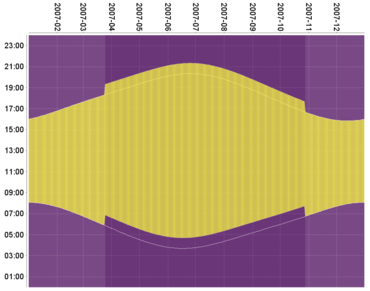Hope you don't forget the catchup by being an hour late ;)
In NSW-Vic 2010
Daylight Saving Begins - Sunday 3 October 2010 at 2:00 am
Daylight Saving ends - Sunday 3 April 2011 at 3:00 am
What is Daylight saving ?!
A practice of temporarily advancing clocks during warmer months so that afternoons have more daylight and mornings have less. Typically clocks are adjusted forward one hour near the start of spring and are adjusted backward in autumn.
This was first suggested by a Kiwi - GV Hudson in 1895.
Effects
Adding daylight to afternoons benefits retailing, sports, and other activities that exploit sunlight after working hours, but causes problems for farming, evening entertainment and other occupations tied to the sun. Although an early goal of DST was to reduce evening usage of incandescent lighting, formerly a primary use of electricity (modern heating and cooling usage patterns differ greatly, and research about how DST currently affects energy use is limited or contradictory).
When
A one-hour shift occurs at 02:00 local time, in spring the clock jumps forward from 02:00 standard time to 03:00 DST and that day has 23 hours, whereas in autumn the clock jumps backward from 02:00 DST to 01:00 standard time, repeating that hour, and that day has 25 hours. A digital display of local time does not read 02:00 exactly at the shift, but instead jumps from 01:59:59.9 either forward to 03:00:00.0 or backward to 01:00:00.0. In this example, a location observing UTC+10 during standard time is at UTC+11 during DST; conversely, a location at UTC-10 during standard time is at UTC-9 during DST.
Oz Facts
Australia has three standard time zones from GMT:
- AWST (western UTC+08 - WA),
- ACST (central UTC+09:30 followed by SA & NT) and
- AEST (eastern, UTC+10 followed by other states)
NSW, ACT, Victoria, South Australia, and Tasmania observe daylight saving time every year. WA, Queensland and NT don't.
- NSW, ACT,Vic and Tas move from AEST to Australian Eastern Daylight Time (AEDT), and clocks are advanced to UTC +11.
- SA and the NSW town of Broken Hill move from ACST to Australian Central Daylight Time (ACDT), and clocks are advanced to UTC +10 ½.
- Broken Hill, NSW follows ACST
- Lord Howe Island follows GMT+10:30
- Residents of towns on the Eyre Highway (including Eucla, Caiguna, Madura, Mundrabilla and Border Village) in south-east corner of WA follows UTC+8:45
Linux, Java (since JRE 1.4 in 2002) and Oracle (since 9i in 2004) uses TZ (timezone) databasefor time zone processing and conversions
Eg:
Get Current Time Zone
SELECT DBTIMEZONE FROM dual;
Converts a timestamp value at a time zone to a TIMESTAMP WITH TIME ZONE value
SELECT FROM_TZ(TIMESTAMP '2007-11-20 08:00:00', '3:00') FROM dual;
Returns the Time Zone Offset
SELECT TZ_OFFSET('US/Eastern') FROM dual;
Misc:
Holidays in NSW
Oracle TZ
Oz DST calendar
Sunrise & Sunset during DST
Clock shifts affecting apparent sunrise and sunset times at Greenwich (reference centre point for Timezone region).



No comments:
Post a Comment